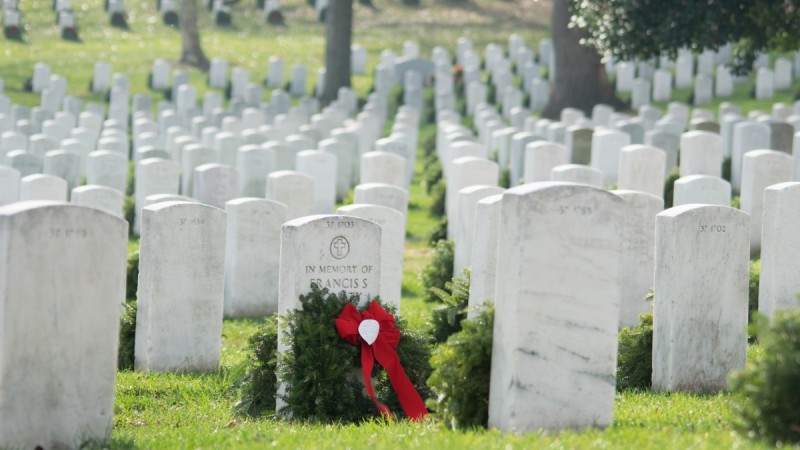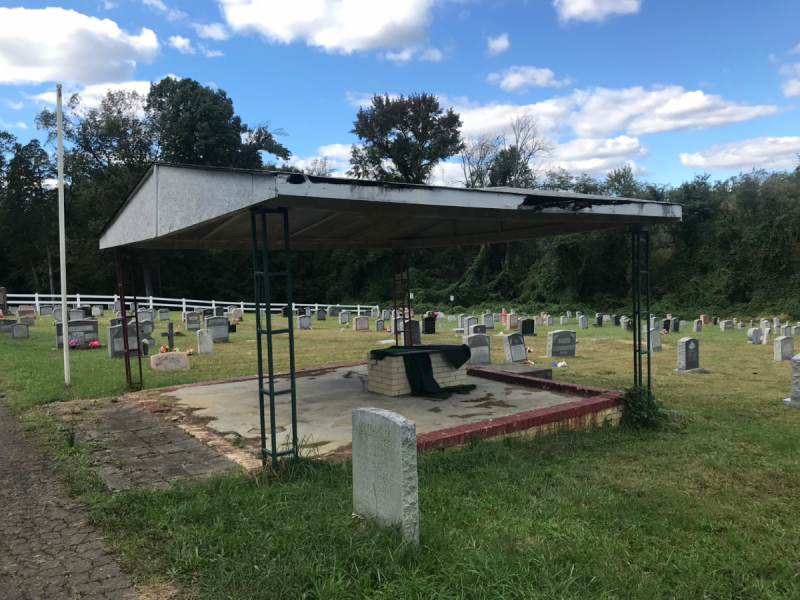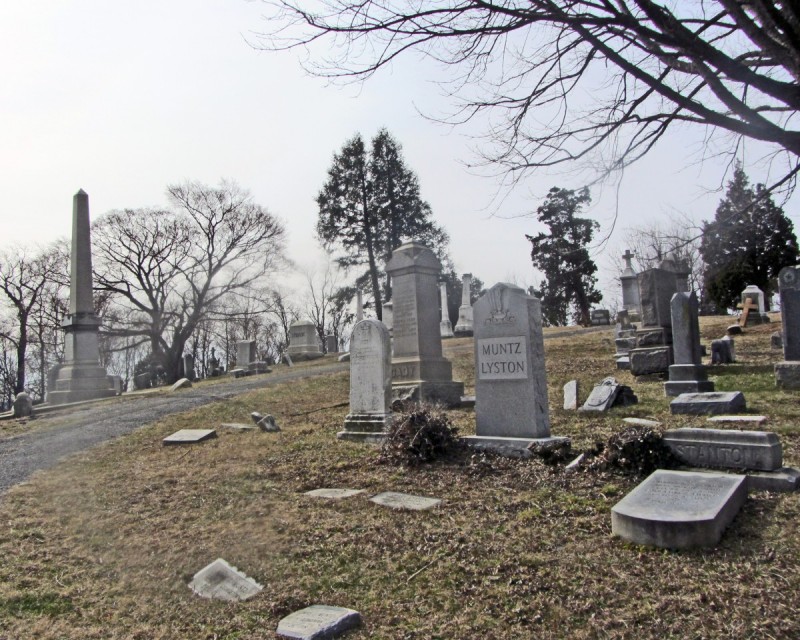Cemeteries use a lot of space and are terrible for the environment. Is there a better way?

Arlington National Cemetery won't have space forever. Image by John Sonderman .
In Berlin, cemeteries are being converted to parks, playgrounds, and housing. This reprioritizing reflects a change in attitude among some Berliners who see their city shrinking as its population increases—without the housing or recreation space to match. It also coincides with a decrease in conventional casket-in-ground burials, as cremations become more popular.
So is Berlin going in the right direction? And are other cities, including those in the Washington region, likely to follow suit?
Yes, cities in our region are running out of space
First, it would be useful to know whether, in fact, the Washington region is running out of space for housing. We know not enough housing is being built, but do we lack space to build?
As it turns out, yes. With DC’s population already past 700,000 and set to hit around 900,000 by 2040, we are now looking into all kinds of vacant buildings (like office parks) and underutilized land (like alleys) as potential solutions to fit in more housing, which we already urgently need.
In Northern Virginia, there are other issues. A lot of open land available for housing is in the far flung corners of the suburbs, away from public transit. They’re not likely to become urban hubs and they’re more likely to have single-family homes and large yards, rather than dense apartment or condo buildings.
As contributor Tracy Loh recently pointed out, much of our land in the Washington region is off-limits to development. We’re only really short on space because so much of the land is off limits for poor reasons that we could change.
How land is zoned for future use in the Washington region. Image by Tracy Loh._619_800.png)
We need a mix of housing types to suit various people’s needs, but housing built where people need to drive long distances to run errands or to get to work isn’t usually as valuable or as enviromentally-friendly as housing placed near public transit and walkable amenities. Cities should aim to curb sprawl, including cemetery sprawl which is terrible for the environment. Of course, because it’s usually more valuable, around transit is typically where land is scarce.
Regardless, our big cities are running out of space, even if not in the next decade. And our cemeteries are already running out of space.
Cemeteries pose significant challenges to the built environment
Even if there wasn’t a housing shortage and lack of space for housing, we would still be running out of space for the dead, because many cemeteries are located in our urban cores that can’t accommodate growth.
This is an issue in many other countries as well. That’s why some of them “lease” graves to families, and after a certain amount of time, the graves are disinterred, the remains given to the family, and the newly-empty grave used for another person. If the family wants their relative to remain in that grave, they must continue to pay for it to be maintained.
Burials change our environment, not only by introducing a lot of different materials to the soil, but also destabilizing it and preventing development.
Catacombs of Paris. Image by Geoffrey Mainland licensed under Creative Commons.
One of the most famous burial sites in the world is the catacombs of Paris. More than six million people are buried in ossuaries underneath the Paris streets. The ossuaries an integral part of tourism in Paris, and they also pose challenges in zoning and building. Very few buildings along this network of tunnels are tall. That’s because the additional height and weight would pose a danger because the space underneath their streets is essentially hollow.
New Orleans is also an example of how burials change our built environment. Since it lies below sea level and floods frequently, residents can’t bury their dead below ground. Water loosens the soil too much and would move the graves. Above ground burial also happens to be part of Catholic Latin and Catholic French cultures. This is how we got the famous cemeteries of New Orleans with its rows and rows of mausoleums.
Unfortunately, this is an issue further inland as well. Some parish cemeteries are far from Lake Pontchartrain, but are near rivers that overflow. Here, they still practice underground burial. Whenever these parishes get heavy rains, caskets are unmoored and pushed to the surface.
Burials are also a big environmental issue
Most traditional casket-in-ground burials today are really, really bad for the environment, but it wasn’t always this way in the US.
Our burial rituals have changed a great deal in the last few hundred years. For the early white settlers, illness and death were common affairs, and family plots were the most economical and matter-of-fact way to remember your loved ones and keep them close. There was no embalming, and if there was a casket, it was very simple and made of wood. Ceremonies were common but weren’t as elaborate as they are today.
The way we bury has also changed the materials we use—notably, we use many more materials—and that has a snowball effect.
Cemeteries may seem "green," but they're terrible for the environment. Oak Hill Cemetery in Georgetown used with permission.
Each year, burials in the United States use 30 million board feet of wood (each board foot is 12 inches by 12 inches by 1 inch), more than 104,000 tons of steel, 1.6 million tons of concrete for burial structures, and 800,000 gallons of embalming fluid, according to an article in the Berkeley Planning Journal. The wood alone could be used to build 4.5 million homes.
Additionally, embalming fluid—which caught on in the US after President Abraham Lincoln was assassinated—is highly toxic, and those toxins can leach into the soil and air. In even small quantities it can irritate the throat and eyes, and in large quantities it can be deadly. Formaldehyde, a key ingredient in embalming fluid, has been labeled a carcinogen, potentially posing a risk to those who work in burial services. Cremation isn’t very environmentally friendly, either. The fire produces pollutants when certain materials in the body melt.
Yet, we persist because we want to respect our loved ones in death as much as we respected them in life. This means holding their memory and connecting it to something tangible, like a grave.
Mary Shelley famously felt an intense connection to her mother, who died soon after giving birth to her. Shelley would frequently visit her grave and read her mother’s writing. The church graveyard became her respite from a turbulent childhood, and offered solitude for her to read and learn. Her intimate awareness of death was a massive influence on her writing.
Everyone deserves a home, even the dead
In Alexandria, Coleman Cemetery is a small, three-acre piece of land that contains roughly 1,200 burials. A few graves had plants on them, and looked like they had been visited recently. While I was there, a tan sedan rolled up and a man stepped out to pay his respects. I saw that one of these gravestones was not like the others. Amongst the graves labeled Banks, Lee, Russell, and other family names, there was one emblazoned with two DC flags and a simple inscription, “In Loving Memory of Our Unclaimed.”
I stopped by Coleman Cemetery, one of the places I’m researching. It’s in Alexandria but is a burial site for many of DC’s unclaimed residents. Ron Reaves, who is/was the caretaker, had this installed so we would know they existed. The story from 2015: https://t.co/xSPgjrzvhF pic.twitter.com/WC7xEd5rTA
— joanne (@joanneliveshere) October 13, 2018
I was curious about this, so I looked it up. The company that operates Coleman Cemetery is the W.H. Bacon Funeral Services company. It has a contract with the DC government to cremate and bury people who died without anyone stepping forward to bury them. These people aren’t necessarily without identities, they were merely unclaimed. Most often, they are those who died while experiencing homelessness, the extremely poor, and the elderly.
The city allows for unclaimed bodies to be cremated, and the W.H. Bacon Funeral Services then buries them in two plots, one of them being Coleman. The DC government does not release names of people who have gone unclaimed, and they are buried together in a coffin. W.H. Bacon’s contract with DC dictates that the company is supposed to provide a grave marker for each burial, according to the Washington Post.
The marker I saw at Coleman wasn’t that. Instead, it looked like a marker that may have been placed by Ron Reaves, who was the cemetery caretaker featured in the Washington Post article. In the article from 2015, he said he would try to use his own money to mark the grave.
Coleman Cemetery. Image by the author.
What happened here? The Washington City Paper perhaps summed it up well in 2001 when it reported on this issue: “In general, unclaimed bodies often belong to people who were neglected in life and are now neglected in death.” I think this goes beyond thinking about cemeteries as being places that make us uncomfortable or impede growth in some way.
As I wrote in my last post, it would be too simple to reduce cemeteries to the premise that they’re wasteful. As urbanists, should we consider the needs of all residents when they are alive and when they die? In the case of the unclaimed residents of Coleman Cemetery, don’t they deserve the dignity of a final resting place with their names attached to their remains? Where should that be, and what should that look like?
Coleman Cemetery. Image by the author.
Today, Coleman Cemetery looks a bit neglected. Many of the gravestones in Coleman have toppled or have broken from their base and others are crooked. Some are covered in dirt or are sitting in mud as a result of the uneven ground collecting water from recent rainfall.There’s a platform for memorial services that looks like it’s seen better days. The grass is tall, and there’s a sign on the grounds that says the grass won’t be cut unless all graves are under perpetual care.
Coleman Cemetery. Image by the author.
The graveyard next to Coleman, the Snowden & Bethlehem Cemetery, looks better—but there are still issues. Some of the gravestones have been uprooted, and are an odd sight as they sit next to roads and sidewalks. The cemetery is right next to a house that was on the market for $1.2 million.
What’s happening to our cemeteries?
It’s a valid urbanist perspective that cemeteries shouldn’t expand any more than they have already. But cemeteries, where they exist already, should be useful and well-maintained and this is an urbanist issue as well. We would be upset if a park fell into disrepair, and cemeteries are not so different.
Cemetery upkeep has been a longstanding issue. In the last eight years, the Rock Creek Cemetery’s water bill skyrocketed from around $3,500 to $200,000 because the DC government added a fee to help clean the Potomac and Anacostia rivers. The fee is added to places with a lot of impervious surfaces where rain would become runoff and end up in waterways, rather than get soaked into the ground. Cemeteries have large acres of grass and need a lot of water, and their impervious surfaces in the way of gravestones and mausoleums also make their water-related costs high.
The cost of burials is also high, and that too makes it harder for cemeteries to maintain their grounds. The high costs of burials impede people from conferring to their family members or friends the same kind of remembrance other people with the funds can get. Cremations typically cost $1,000 or more. The average cost of a casket is $2,000. Gravestones can cost hundreds of dollars to $10,000. The burial land and care for the cemetery costs money, too.
When families can afford to pay for perpetual care, it helps maintain the grounds. When they can’t, or when remaining family members die, it can change the financial equation.
Holy Rood Cemetery in Georgetown. Image by Natalie Maynor licensed under Creative Commons.
Perpetual care is also an issue. In Virginia and Maryland, all cemetery companies need to set up a perpetual care fund, which is a pool of money used to maintain the cemetery grounds. This may seem like it would extend to the gravestones, but it does not. Cemeteries have to have multiple funds to cover their own grounds, like the grass and fences, and another fund to take care of their gravestones.
In the case of Holy Rood Cemetery, Georgetown University has been accused of intentional neglect for decades. In the 1980s, the university planned to disinter the bodies (approximately 7,000 of them) and develop on the land. This plan was blocked by alarmed residents and people whose family members would be moved. In November, the university and Holy Trinity Catholic Church announced a plan to restore the cemetry and make repairs.
Unsurprisingly, with the environmental challenges posed by burials and the high costs involved, some people have considered alternatives to conventional burial. Stay tuned for the next post in this series!
